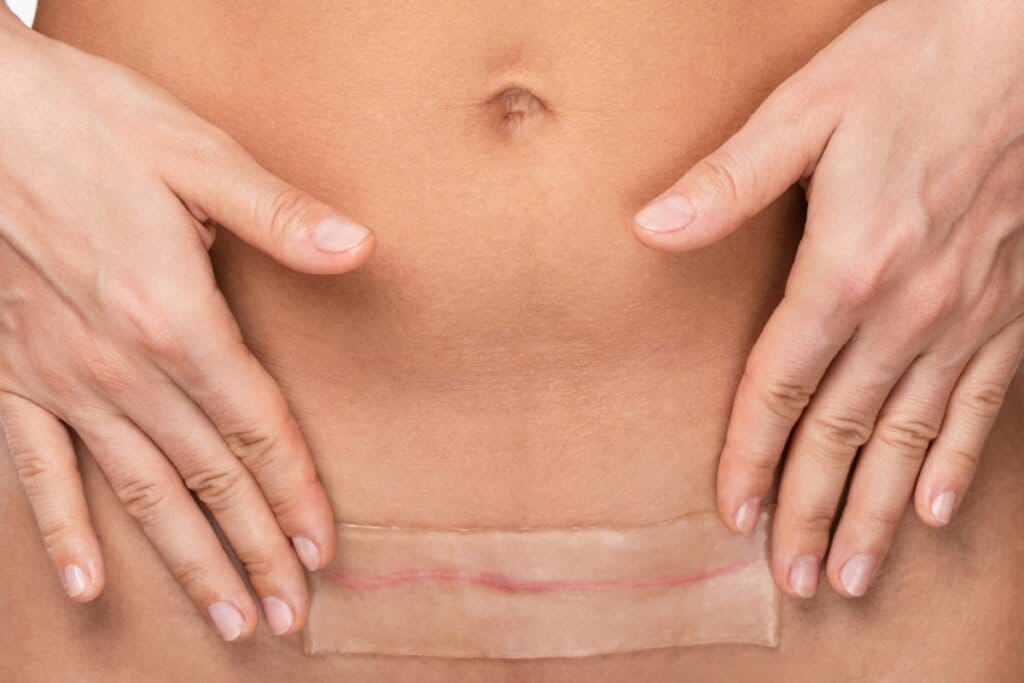
If you have recently had surgery, you may be wondering, “Are my incisions infected?” This is not always an easy question to answer at home, as some postoperative swelling, discomfort, redness, and discharge are normal occurrences after surgery. Still, these same symptoms can also be a sign of infection, so it is important to be aware of possible complications and to recognize when your body is telling you something is not right.
In this post, learn the signs and symptoms of a potential infection, the associated risks and treatment, and the steps cosmetic surgeons certified by the American Board of Cosmetic Surgery take to prevent infection.
What is an infected incision?
An infected incision can occur when bacteria enters the incision site during or after surgery. Symptoms of an infection can range from mild to severe and may present in a number of ways.
How can I tell if my incision is infected?
There are several signs and symptoms you can look for at home:
- Redness
- Warmth
- Swelling
- Pain (that increases or becomes severe)
- Fever
- Pus or drainage
Fortunately, incision infections are rare; only 0.5%-3% of patients will experience an infection at or adjacent to the incision site. If you suspect that your incision may be infected, contact your surgeon for professional guidance on the next steps.
Types of drainage
Not all drainage is a red flag, so it is helpful to educate yourself on the differences between normal drainage and infection drainage.
Normal incision drainage:
- Serous drainage. This is a clear or slightly yellowish fluid that may appear in the early stages of healing. It contains water, salts, and other substances that help to clean and protect the incision.
- Sanguineous drainage. This is a bright red, bloody fluid that may appear in the first few days after surgery and is caused by bleeding from small blood vessels along the incision.
- Serosanguineous drainage. This is a mixture of clear and bloody fluid that may appear as the incision continues to heal.
Abnormal incision drainage:
- Purulent drainage. This is a thick, yellowish or greenish fluid that may have a foul odor and indicates an infection.
In some cases, your surgeon may take a small fluid sample to test for bacterial culture to identify the type of bacteria causing the infection.
What are the risks of an infected incision?
An infected incision can cause a range of complications, some of which can be quite serious.
Delayed healing
When bacteria enters the incision site, your body’s immune system responds by sending white blood cells to the area to fight off the infection. This can cause inflammation, which can slow the healing process and potentially cause prolonged pain and discomfort.
Abscesses
An abscess is a pocket of pus that forms at the site of infection. It can lead to an inflammatory response that causes white blood cells, dead tissue, and bacteria to accumulate, creating a pus-filled cavity. Abscesses may feel like a lump or bump under the skin and can be tender to the touch or painful. If left untreated, an abscess can grow and spread to other areas, causing further complications.
Sepsis
Sepsis occurs when the body’s response to an infection damages its own tissues and organs. Bacteria that enters the incision site can spread via the bloodstream to other parts of the body, causing a systemic infection. Sepsis causes a range of symptoms, including fever, rapid heart rate, difficulty breathing, confusion, and low blood pressure. In severe cases, sepsis can lead to septic shock—a potentially life-threatening condition that requires immediate medical treatment.
Increased scarring
Inflammation triggered by the body’s immune response can produce excess scar tissue at the incision site, creating a more noticeable scar. Additionally, if the infected incision requires surgical debridement (removal of infected tissue), this can cause more trauma to the incision site, delay healing, and leave more noticeable scarring.
What steps will my cosmetic surgeon take to limit the risk of infection?
A board-certified cosmetic surgeon will take several steps to prevent incision infections before, during, and after surgery. These steps may include the following:
- Preoperative evaluation. During your consultation, your surgeon will review your medical history, perform a physical exam, and conduct any necessary lab tests to assess your overall health and identify any factors that could increase your risk of infection.
- Antibiotics. Your surgeon may prescribe antibiotics before and after surgery to help prevent infection.
- Sterilization. Your surgeon will ensure that all instruments and equipment are properly sterilized and your surgery is performed in a fully accredited surgical facility.
- Skin preparation. The hair at the incision site may be removed, and the area will be cleaned with an antiseptic solution or other cleansing agents before any incisions are made.
- Postoperative care. After surgery, your surgeon will provide wound care instructions and guidelines for resuming normal activities. They will also closely monitor your progress at pre-scheduled follow-up appointments.
By following these steps and taking appropriate precautions, a board-certified cosmetic surgeon can further reduce the risk of incision infections and achieve optimal aesthetic outcomes for their patients.
How can I prevent incision infections at home?
While not all incision infections can be prevented, there are steps you can take after surgery to help reduce your risk of infection:
- Follow all aftercare instructions. Your surgeon will provide specific instructions to follow after surgery and throughout your recovery period. Follow these instructions carefully, and contact your surgeon with any questions or concerns about aftercare.
- Keep the incision site clean and dry. This includes changing bandages as directed and avoiding activities that could cause the incision site to become soiled or wet.
- Wash your hands frequently. Washing your hands helps prevent the spread of bacteria—wash your hands before touching your incision site and before and after changing your bandages.
- Avoid smoking. Smoking impairs your ability to heal and increases your risk of infection.
How is an infected incision treated?
Treatment typically includes a combination of antibiotics and wound care. The specific treatment plan will be determined after an in-office exam.
- Antibiotics. The type and duration of antibiotics will depend on the severity of the infection and the type of bacteria causing the infection. In some cases, intravenous antibiotics may be necessary to deliver a higher dose of medication directly into the bloodstream.
- Wound care. The infected incision will be cleaned and dressed by your surgeon, and you will receive specific instructions on how to clean and dress the infected incision site at home.
- Surgical debridement. In more severe cases, infected tissue may need to be surgically removed to prevent the infection from spreading further.
- Pain management. Your surgeon may prescribe pain medication or suggest over-the-counter pain relievers to help manage any discomfort or pain associated with the infection or the wound care process.
- Follow-up care: You must follow up with your surgeon to ensure the infection responds well to treatment and to be monitored for any signs of complications.
Early treatment helps prevent additional complications and encourages a faster, smoother recovery.
Are you considering cosmetic surgery? Choose a board-certified cosmetic surgeon
Surgeons certified by the American Board of Cosmetic Surgery (ABCS) undergo rigorous training and testing to earn their certification, which includes completing an approved residency program, extensive surgical training, and ongoing education to stay up-to-date on the latest techniques and safety standards. ABCS surgeons are held to the highest ethical and professional standards and are committed to providing their patients with optimal care before, during, and after their procedure.
By choosing a board-certified cosmetic surgeon, you can rest assured you are in safe hands, with a surgeon who has the skill to provide aesthetically pleasing cosmetic surgery outcomes. Find an ABCS board-certified surgeon near you »







